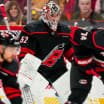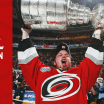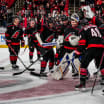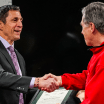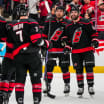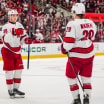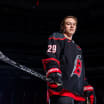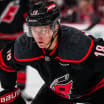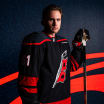Twenty years ago, the doors of what was then known as the Raleigh Entertainment and Sports Arena opened. The Carolina Hurricanes were home.
The road to Oct. 29, 1999, was long and winding and featured a number of pit stops and detours along the way, but the payoff and the memories that have followed in the 20 years since make it all worth the journey.
What follows is an oral history of Opening Night at the ESA, the lead-up to it, the night itself and the evolution of the building and fanbase since.
'It Was Electric': An Oral History of the Canes' First Game at PNC Arena
Canes hosted Devils on Oct. 29, 1999, in first event at Raleigh Entertainment & Sports Arena
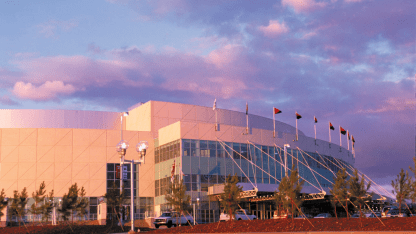
By
Michael Smith @MSmithCanes / CarolinaHurricanes.com
Genesis
In the beginning - in this case, the 1980s - what would become the site of a premier sporting and entertainment facility was nothing more than trees, a grass field and a vision for something bigger.
Dave Olsen, Executive Vice President/General Manager of PNC Arena: "It started with Jimmy V [Jim Valvano]. It was Jimmy V's dream, along with some big Wolfpack folks that wanted this thing to happen. Steve Stroud was the one who spearheaded the whole thing. He championed it right through. He had all the right connections to get the funding and political support it needed back at that time. He was very, very instrumental, and it was because of his relationship with Jimmy V that this all started."
The proposed project picked up steam in the early to mid-1990s. Funding was secured. Designs (and redesigns) were drawn up. A plan was put in place. And all of that would change, of course.
Olsen: "It was positioned to be a multi-purpose entertainment facility, but it was not budgeted to have the frills and things it does now. It was budgeted to basically be a high-end basketball building that could do the circus and Disney on Ice. It was never where it is today.
"Back then, a lot of people weren't even sure. They'd never had anything of this magnitude. Other than going over to Chapel Hill, Reynolds was the biggest thing in the market. All the entertainment at the time typically went to Dorton Arena, which was you know what that is. It was going to be a significant change, and it was interesting politically. At the time, the mayor was against the project and fought hard against the project. The Authority members worked hard to make sure the project kept moving forward regardless of the political stuff going on. When I first moved here, it was quite the fight that was happening."
The Hartford Whalers played their final game in Connecticut on April 13, 1997. In early May, Owner Peter Karmanos announced that the team would relocate to Raleigh. That June, the Carolina Hurricanes were born.
Scott McGeary, Season Ticket Member since 1998: "Acquiring the team was a weird process. It wasn't like it was years of speculation. All of a sudden it was thrown out there that it was a consideration, and I, quite honestly, thought it was just bargaining with Hartford to get a better arena. 'Oh, yeah, we're going to move to Raleigh.' 'Oh, right, you're going to move to Raleigh. Yeah, yeah.' Then, all of a sudden, it happened. It was, 'What?!' and we had this team, but we didn't have an arena and it was going to be a couple of years."
Groundbreaking
The first shovels pierced the ground at what would become 1400 Edwards Mill Rd. during a groundbreaking ceremony on July 22, 1997.
With eyes on October 1999, a frenetic construction process ensued over the next two years. More redesigns were made to the architecture of the building in order to accommodate a National Hockey League team.
Olsen: "Pete had $48 million in the building, and it was my responsibility to make sure we spent it on things that were needed in the building at the time. If you went back to the original building, it was a $58 million building and ended at $165 million. If you look at the redesign, the box office was like one at a football stadium with exterior exposed. The concessions stands were going to be nothing more than what they do across the street. Push hotdogs across the counter. No frills, nothing. Basically, the original building stopped at the box office wall on the exterior. The NHL media had to be elevated. So, where the fifth floor currently exists, there were seats. There was no fifth floor.
"It was crazy. Most of those two years were 18-hour days here on the site, just making sure the contractors were doing what they were doing. We had job meetings once a week with all the contractors, and nobody got along, which was the worst part. Because of the way the state statute said it had to be bid, everybody was their own prime contractor. … There were literally days when I was separating grown men at the chest who wanted to kill each other in the trailer. It was fun. It was crazy fun.
"David Horning was a pretty intense dude. All this bickering was going on. He came in one time with a handful of championship rings. I remember him throwing them across the table at everybody like they were dice. He just went on this speech like George Patton in World War II. Nobody had any idea where he was going with the speech, but it was the funniest f------ thing I remember. Holy s---. It was crazy times like that."
Greensboro
Meanwhile, the Hurricanes had a business to build and hockey to play in North Carolina. With the new arena in Raleigh not set to open until the 1999-2000 season, the Canes had to find a temporary home. A team office popped up in Morrisville, while home games were played 90 minutes west at the Greensboro Coliseum.
Bates Battaglia, Forward: "It was straight up awful. We'd have our pregame skate here and then hop on the road right after. Have a pregame meal in Greensboro. Stay at a hotel for the afternoon for a pregame nap. Some guys stayed at home and drove out later in the day. Not everybody did the same thing. You were kind of jumbled up. It was awful. Just to have to do that 41 times for two seasons was pretty rough."
Olsen: "Hell, if you ask me. We had an office staff in an office complex over in Morrisville. It was made up of some ticket operations people who came down from Hartford, corporate sales guys who came down from Hartford. … They were kind of the ones who got us up and going."
McGeary: "Probably the most stupid thing I ever did was not buy a season ticket that first year, but I went to all the games or every game I could possibly get to. They used to have a bus that would come - I can't remember where it exactly it picked us up - and there would be about 40 of us on this bus. We'd drive to Greensboro and come home after the game. It was kind of fun. … Attendance was not good, and I started getting kind of panicky the first season, like they're not going to stay around. I said they needed to have more season ticket members, so I got my season ticket the second year and have had them ever since. I don't want to say it was awful. It's just that it wasn't well-attended. You just felt kind of embarrassed when they had to fill the upper seats with drapes. There was so much enthusiasm about finally getting the team here. People in Greensboro, and I understand it, they realized this wasn't their team long-term, so they didn't feel the allegiance to it like we did and do in Raleigh."
With 86 points and a 34-30-18 record, the Canes finished atop the Southeast Division in 1998-99, their second and final season in Greensboro. They were ousted in six games by the Boston Bruins in the first round.
John Forslund, Play-by-Play Announcer: "That was a really good team. I thought that team could have done some damage had they gotten by the Bruins. It's an excuse, but I really think the logistics of the back-and-forth had finally gotten to that team, certainly after they lost Game 5. They were gassed. I remember driving back and passing Glen Wesley. We used to pass each other all the time on the highway because he lived out in Cary close to where we were. You could see it on his face and a couple of the other players, too. They were vacant. That took a lot of gas out of them. And then Game 6, that was it."
The Road to Raleigh
By the summer of 1999, the arena construction project was in the home stretch - at least the spaces that needed to be complete to stage a hockey game in late October.
Olsen: "It was a Saturday morning. They called me in to look at the arena floor. This was probably the second week of August. There was so much hatred amongst everybody. They called me up and said, 'I need you to look at this. The floor doesn't meet spec. You have every right to stand here right now and tell them to rip it out and put it back in.' But we were a month away. There was no way we could do that. We'd never make it. … If you ever look when just the concrete is down, right in front of our bench, the left-hand door, there's a dip in the floor. It's been there for 20 years.
"I was the first one to skate on the ice, and it was I want to say September of '99.
"Maybe the smart guy I am, I had these guys put a broomball game together at the end of the job. I cut them all loose on each other. I refereed it, and it was a throwdown. It was the dumbest idea I ever could have come up with, putting those guys on ice with brooms in their hands. Not very smart."
While the finishing touches were being put on the Raleigh Entertainment and Sports Arena, the Hurricanes hit the road for nine straight games to begin the 1999-2000 season.
Battaglia: "It was a huge road trip. I think I was rooming with Paul Coffey, which I thought was pretty sweet because I grew up watching him, and he was fairly new to the team. I just remember it was a big trip for us because it was kind of like big team bonding, getting everybody on the road early in the season. I do remember thinking it was going to be nice to be finally in our home arena instead of driving to Greensboro. I think everybody was fired up."
Jeff Daniels, Forward (and current Assistant Coach): "It's hard. At the start of the year, it's not bad because you get a chance to get together as a team. The pressure is kind of more on the opposing team because they want to get off to a good start in their own building, so we just came in and knew in the back of our minds that the home opener was down the road. Just like any year, you had to focus on where you were at in that point of the season. It's not ideal to start with that many games on the road, but you survive and get ready for the home opener."
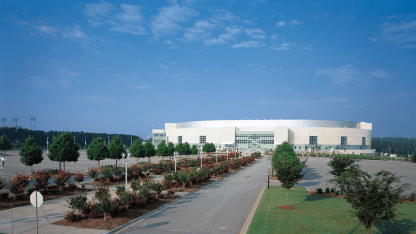
The Canes brought a 4-2-3 (11 points) record home, and six days later, it would be time to christen the new building.
McGeary: "What I remember is kind of the backdrop of what was going on with the team. We'd made the playoffs the year before and had kind of a disappointing exit from the playoffs. It was kind of a heartbreak. Then, we lost one of our assistant captains, Steve Chiasson, in an accident that spring, right after the season was over. That was really heartbreaking. Then our bum captain (Keith Primeau) decided to hold out and not play. He wanted more money, and I think he had done that same crap before. There was a lot of stuff going on with the team, and as I recall, the arena wasn't quite finished yet, so we had to go on this incredibly extended road trip, minus a captain, having lost Steve Chiasson. We did OK. Finally, the arena was opening, and we were playing our first game. There was certainly excitement about that."
Chris Huffine, Video Coach: "I know there was excitement for us because we had really not even been allowed in the arena. I got a couple tours before the season started to see the infrastructure. When everybody got into the arena, it was still not completely completed."
Forslund: "It was strange because we didn't even see the building. They brought us in and said, 'Here it is,' and there was still work to be done. We were like, 'OK.' I can't even start to explain what those two years were like in Greensboro for someone who didn't play. For the guys who actually had to play and go through all of that, they were just so happy to finally get back to a semblance of a home schedule. My first recollection when I walked into the place was the size of the lower bowl. I couldn't believe the amount of seats in the lower bowl. I couldn't believe how big it appeared, although Greensboro Coliseum is a vast, huge building."
McGeary: "What I remember was how red it was with all the seats. I think I had come in to see it the day or so before, and it was so vividly red. I said, 'Wow.' It was unlike Greensboro. Now, we finally have a team. The arena was clearly state-of-the-art. I thought at the time our scoreboard was fantastic. Now, in retrospect, not so much. The ice looked wonderful. The team looked wonderful."
Olsen: "October 27, two days before. We got the certificate occupancy. 48 hours before the first event. We had no soft opening. We had nothing."
Opening Night
Ready or not, it was time to cut the ribbon and open the doors. October 29, 1999. New Jersey Devils vs. Carolina Hurricanes. The beginning of an era in Raleigh and North Carolina.
Battaglia: "Anybody will tell you it's huge to be playing at home, I don't care where you are. Whether you're attracting a crowd or not, it's always nicer to be at home. To finally have one after two years was a pretty big deal for us, I think. Just to be able to call it home, it was the real deal."
Daniels: "You want your home building. You want to come to a place every day that you can call home. Just the excitement of the new building, a new start in a new city after coming from Hartford a couple years prior. There was a fanbase here to begin with … so people knew the game. To be part of that is special."

Forslund: "I feel like there was a general sense of excitement, to have a facility like this. They had waited a long time to build something like this, the school did, too. This was huge. It was a big landmark."
Huffine: "I thought this place was like the Taj Mahal."
There were, of course, kinks to work out, some perhaps bigger than others.
Olsen: "There were a couple wrecks out on the highway that we had no control over, but the parking staff had no idea what was going on. We literally got the keys two days before. We had no preparation for anything. We just got thrown to the wolves right out of the gate. Then, concerts started. The year started. There was no looking back. Opening Night, I don't even remember Opening Night. I remember they had a party in the restaurant I never got to see. Pete Karmanos, there was a newspaper article. He had been sitting in traffic so long that he got out to help the traffic people. All that was talked about in the paper the next day was the traffic. It was front-page. The parking guy I hired from Michigan came in the very next day, put his keys on my desk and said, 'I'm going back to Michigan.'"
Forslund: "The biggest memory I have is that we couldn't see the shot clock. That was a major concern. We got up to the press box, and we couldn't see the shot clock. To Dave Olsen's credit, he was able to figure out a way; we had to park a hard camera on the shot clock, and we had a monitor in all the booths with that shot to see the shot clock. That wasn't discovered, I don't believe, until we played. Like, 'Wait a minute. We can't see the shot clock. We've got a problem here.' We couldn't see that."
Olsen: "I don't remember anything about Opening Night expect the problems we had. Everyone else was having fun except me. Problems were stacked up higher than the roof."
Andrei Kovalenko scored the first goal in Raleigh at the 4:30 mark of the second period to put the Hurricanes up 1-0. Later in the period, Nolan Pratt dropped the gloves with Randy McKay. The Devils then scored three straight goals in the third period before Battaglia got the Canes back within a goal. McKay's empty-net tally with four seconds left in regulation sealed the Devils' 4-2 win.
Huffine: "It was definitely a surreal feeling. The energy in the building - this building has always had incredible energy, but I do remember having those chills on the bench when you're introduced, just the vibration of the building. When the fight happened and Kovalenko scored, when the fans cheered and the stuff fell out of the ceiling, the way the building sounded, it was incredible. I realized at that point in time how loud the building was. And they were cheering the whole game. It was a neat experience. To have something you can start envisioning that this is your home … it was nice."
Despite the hiccups and despite the outcome, there was no mistaking the atmosphere and the excitement of finally being home.
Forslund: "It was electric. … It was very exciting. I think it's funny that we started with a random game against the Devils in '99, and they would become a rival."
Huffine: "It was a good crowd, and there was some excitement in the building. … Our fans cheered all the time. So much of the game in Canada, they cheer at certain times, and then it's quiet. We're kind of like the basketball crowd. It was just crazy, crazy, crazy."
McGeary: "We were so excited to finally have a team in Raleigh. People were so, so pumped. Raleigh, to that point, had never had a professional team. Charlotte had theirs. We were kind of the second fiddle, and this kind of put us on the map. People were really pumped. That kind of level of enthusiasm, we've never really lost it. There have been times when the team has played poorly and you don't get a sense of it, but this arena has always really lent itself, I think, to being noisy. I don't know if that was deliberately built into the arena or just happenstance, but it is just a loud arena. I think that was really evident that first game with all the excitement going on and the team making its first appearance here in Raleigh. There was a loyal core of us that traveled to Greensboro the two years previously, but all of a sudden you could see the potential for this area."
20 Years Later & Beyond
Countless Hurricanes memories have been forever preserved inside the walls of the arena in the last 20 years. A run to the Stanley Cup Finals in 2002. The NHL Entry Draft in 2004. A Stanley Cup championship in 2006. A deep playoff run in 2009. NHL All-Star Weekend in 2011. Another deep playoff run in 2019.
Battaglia: "The run to the Cup when I was there in '02, that was the most fun I ever had playing hockey."
Daniels: "It's been incredible. When we first got here, you didn't see much. Then, all of a sudden, minor hockey started taking off. You start seeing kids playing road hockey in the streets in your neighborhood. You see how much it's grown since then to a point now where the minor hockey system has really taken off, the Learn to Play program, the First Goal program. There's definitely an interest in the game. It was new to a lot of people, but at the same time, there were a lot of people who were transplants who knew the game, and now they have a chance to come to building and have a team they can call their home team and cheer them on."
PNC Arena 20th Anniversary
Forslund: "Every time there's been a step taken, it's been a test, and it's like taking the test and passing with flying colors. The '01 first playoff series here. OK, going to get killed by the Devils, right? But, no. They started to get better within the series, won the game here in overtime, came back and got the standing ovation when it was all over - that was the beginning of, how will the market wrap their arms around the team? Then what happened in '02 was magical. Then there was the first big event in '04, the Draft. How is a Draft going to go over here? There were still people saying, 'No one is going to pay attention. No one is going to come. It's June. Who's going to go to this?' The building was as electric as you could have for a game. I had been to so many Drafts before that in other cities, and it didn't have that atmosphere. It was incredible. Then, you had to survive a canceled season. You come back from that. How was the market going to embrace the team after that? Well, it was pretty easy to embrace that team. Then the run to the Stanley Cup. Then the All-Star Game. My point is, and it's still happening even last year - how will the market respond after 10 years? You saw what happened. That's what I see about this place. That's what has made it special for hockey here. It's a place where a lot of experiments have taken place, and they've all passed. It's been discovered that it's a great building for hockey."
The Raleigh Entertainment and Sports Arena became the RBC Center and is now PNC Arena, and just as the name has evolved, so has the building itself. Transformations, both cosmetic and practical, are evident inside and out. A structure built, maintained and updated to withstand the test of time, now 20 years later and beyond.
Rod Brind'Amour: "They've done a beautiful job, I think, keeping this building fresh and updated. It doesn't feel old at all compared to some buildings I've been in that are 20 years old. … It's been a good place for us, especially lately. The atmosphere has been really positive with the fans, and I think it's shown in the way our players have accepted that and fed off it."
Huffine: "I still love, to this day, pulling into the arena. … You've got people tailgating. It's such a pretty area and a nice arena."
Olsen: "Something I'm personally very proud of is that there is nothing in this building that doesn't have my DNA on it. Every decision that was made to change, recommendations for change, overseeing the projects and everything has been through me. There's nothing in this building that didn't either start on this desk or start on someone else's desk to get to my desk. … I can't tell you how many of those construction projects have literally started on a piece of paper or a napkin sometimes with my contractor saying, 'Hey, I want to do this.' He'll sketch it out on a piece of paper and turn it into something. If they fired me or if I left here tomorrow, I'm going to walk out of here knowing my thumbnail is on everything that ever happened in here, and that's pretty cool."
McGeary: "I am a diehard Canes fan. I guess that's pretty obvious. People make fun of me because I am the eternal optimist when it comes to the Canes. They're my team through thick and thin. I stick with them and always will. I can't imagine not being a fan. It's just a part of my life now, a big part of my life. I love this team."


